Remember That Time Boeing Wanted to Turn the 747 Jumbo Jet Into an Aircraft Carrier?
Boeing once studied turning a 747 widebody airliner into a flying aircraft carrier.
The plane would have carried up to 10 “microfighters” into combat.
The concept was never built out, but a similar system could take place using uncrewed drones.
In the 1970s, Boeing worked on a project that would have turned jumbo jets into flying aircraft carriers. The Airborne Aircraft Carrier project involved converting the Boeing 747, the largest passenger jet flying at the time, into a mothership capable of launching tiny fighter jets. Although never built, the concept lives on in spirit in DARPA’s new “Gremlins” drone program.
✈ You like badass planes. So do we. Let's nerd out over them together.
One of the most enduring aviation dreams of the past 100 years has been the flying aircraft carrier. A flying aircraft carrier would be able to respond much more quickly to crises than seagoing aircraft carriers, and this speed would also make a floating flat-top more difficult to destroy. The idea of an enormous plane or dirigible carrying smaller planes is also undeniably cool.
In the 1970s, Simple Flying reports, Boeing commissioned an internal study to examine the feasibility of turning its largest passenger jet, the 747, into a flying aircraft carrier. The Airborne Aircraft Carrier (AAC) would carry up to 10 “microfighters” (small crewed fighter jets) and launch and recover them in flight.

The plane would use an internal conveyor belt system to send out two fighters every 80 seconds, launching the entire “air wing” in 15 minutes. Once the fighters' mission was complete, the 747 would winch them back aboard, where the pilots could rest and even sleep in their own quarters while the planes were refueled and rearmed.
The AAC was a way to project air power quickly into a crisis zone. Just 10 AACs flown into a hot spot would bring with them a total of 100 combat-ready fighter jets. Another possibility was as an escort for bomber fleets: An AAC could accompany a flight of B-52 Stratofortresses into combat, releasing the microfighters to deal with any interceptors attempting to shoot down the big, lumbering bombers.

But as cool as the flying aircraft concept was, there were major problems. For one thing, air travel wasn't nearly as safe as it is today, and there would invariably be accidents. Every crash involving a fully loaded 747 would destroy up to 11 airplanes and kill 11 sets of pilots. Second, the conveyor belt, launch, and recovery system would have to be invented and fitted to the 747.
Another problem was the “microfighter” concept. There was no such thing as a small fighter jet capable of fitting in the belly of a 747, and the plane would have to be developed. Engineers would face some serious tradeoffs in building a small, crewed fighter: With so little space onboard, would they emphasize speed, range, radar, or weapons?
A microfighter flying over the Soviet Union would face off against an interceptor like the MiG-25 Foxbat, a plane that had a powerful radar and could fly at speeds of up to Mach 3. Any plane squaring off against a microfighter would almost certainly be vastly superior to the microfighter. The U.S. Air Force could develop the best microfighter possible for an insane amount of money, only to have it outclassed on the aerial battlefield.

The AAC’s biggest problem? The flying aircraft carrier was already obsolete.
As B-52 bombers learned in the Vietnam War, air defense surface-to-air missiles like the SA-2 Guideline were a greater threat to bombers than fighter jets, and the AAC had no answer for missiles. Boeing likely also wasn't aware of the U.S. government’s secret research and development into stealth technology, which would see stealth fighters and bombers simply flying around enemy defenses instead of tackling them head-on.
The B-1B Lancer and B-2A Spirit stealth bombers, introduced a decade later, were designed to fly undetected into the Soviet Union, and thus didn’t need a fighter escort.
Despite all the problems that killed the AAC, however, the dream still lives on.
The Pentagon’s X-61 Gremlins project is developing uncrewed aerial vehicles that can be released from a flying C-130 Hercules. The Gremlins drone could be outfitted with sensors, jammers, or weapons to accomplish a specific mission and then be recovered by the transport plane or glide to a landing at a predetermined spot. The small, turbine-powered drone is cheaper and much easier to develop than a crewed microfighter.
Who knows? With the 747 aging out of airlines around the world, the U.S. Air Force could even buy some of the planes and convert them into Gremlins carriers. The AAC may very well fly—just without fighter pilots.
You Might Also Like

